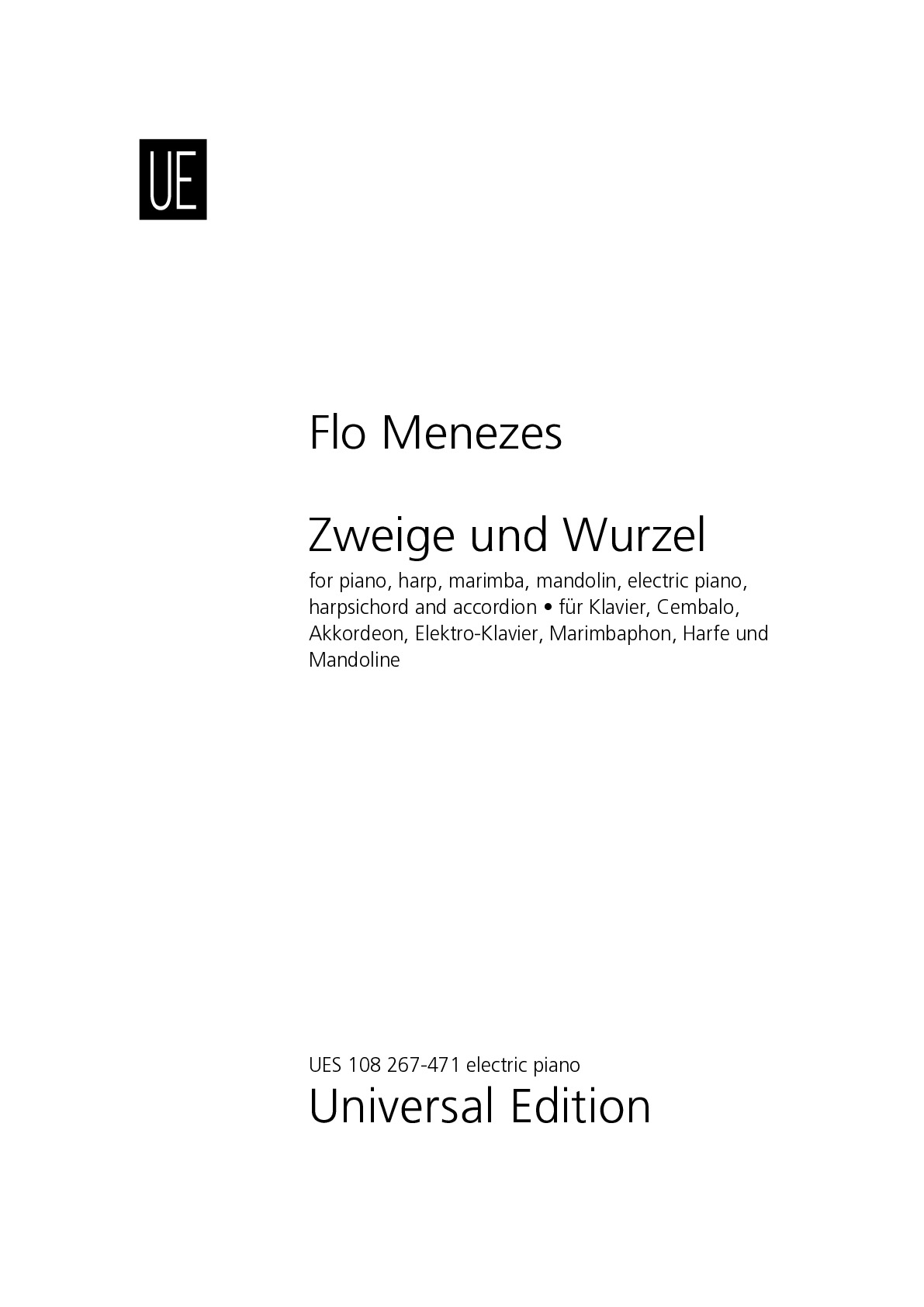.png)
Digital edition
immediately available as PDF
€7.95
Payments:
Shipping:
Flo Menezes
Elektro-Klavier (Zweige und Wurzel)
UES108267-471
Type: Stimme
Format: 210 x 297 mm
Pages: 8
Digital edition
immediately available as PDF
€7.95
Payments:
Shipping:
Description
Conception and material of Zweige und Wurzel
Zweige und Wurzel (port.: Ramos e raiz; English: Branches and root) was composed on two days of February 2022 as a commission from the Dutch instrumental group Spaceship Ensemble, from Den Haag, Holland, and constitutes a satellite work of my second Opera Oposicantos, in the middle of its conception and writing phase. All its material derives from Lied 3 of this Opera, which in turn derives from a fragment of Mahler in Transgress (2003), having undergone subtle transformations and radical re-instrumentation.
The piece is part of “The Carnival of Futuristic Animals” project, described by the Spaceship Ensemble as follows:
"The Carnival of Futuristic Animals is a project inspired by one of The Netherlands’ most iconic scientists: Dutch theoretical physicist and professor at Utrecht University, Gerard ’t Hooft. Winner of the Nobel Prize in Physics in 1999 for his work on Gauge Theories, ’t Hooft’s ingenuity and curiosity spreads beyond physics into areas such as biology, music, art, literature and many others.
Throughout the years, his involvement with these interests led Dr. ’t Hooft to produce a series of drawings portraying futuristic creatures inspired by how animals might evolve (https://webspace.science.uu.nl/~hooft101/evolve.html).
In ’t Hooft’s own words: “Humanity has learned to copy nature. We can swim, float, walk, jump, climb, dig, run and fly, just as many animals do. Some things we do, however, appear not to exist in Nature. Not yet. What you should know is that evolution in the animal kingdom proceeds slowly. Our abilities to ride on wheels, sail, ski, skate and space travel will also emerge in the animal kingdom, but just not yet. In this revealing note, I display the likely ways in which these missing niches will be occupied...”
These fantastic drawings sparked our imagination to develop a very special music program that will be reminiscent of Le Carnaval des Animaux by Camille Saint-Saëns; each movement of the piece portrays one of ’t Hooft’s creatures.
The final product of this Spaceship Ensemble project will be a live music concert with the presentation of eighteen short musical works specially commissioned for the event. In addition to the commissioned compositions, the project will also include the creation of a set of original Arduino musical hardwares designed to enhance the novelty and uniqueness of this musical-scientific ‘ecosystem’."
Among 't Hooft’s drawings, I chose the one that really interested me: the last one, which shows different territories connected by roots from which trees grow. The drawing, divided almost in proportion to the Golden Section by a brittle duct, does not resemble the others and has no “futuristic animal” at all in it, but looks more like a Paul Klee drawing...
Some of Paul Klee’s reflections are a constituent part of the texts elected for Oposicantos, and Gerard 't Hooft’s drawing refers directly to two of the texts used in this Opera of mine, respectively by Klee and Franz Kafka, cited as apocrypha in this score. Below are their translations, carried out by myself:
Denn wir sind wie Baumstämme im Schnee. Scheinbar liegen sie glatt auf und mit kleinem Anstoß sollte man sie wegschieben können. Nein, das kann man nicht, denn sie sind fest mit dem Boden verbunden. Aber sieh, sogar das ist nur scheinbar.
Franz Kafka: Die Bäume
[For we are like tree trunks in the snow. Apparently they are slippery, and with a little push one should be able to move them. And no, this one cannot, for they are firmly tied to the ground. But you see, even this is only apparent].
Lassen Sie mich ein Gleichnis gebrauchen, das Gleichnis vom Baum. Der Künstler hat sich mit dieser vielgestaltigen Welt befasst, und er hat sich, so wollen wir annehmen, in ihr einigermaßen zurechtgefunden […]. Diese Orientierung in den Dingen der Natur und des Lebens, diese vielverästelte und verzweigte Ordnung, möchte ich dem Wurzelwerk des Baumes vergleichen. […] So steht [der Künstler] an der Stelle des Stammes. Bedrängt und bewegt von der Macht jenes Strömens, leitet er Erschautes weiter ins Werk. Wie die Baumkrone sich zeitlich und räumlich nach allen Stellen hin sichtbar entfaltet, so geht es auch mit dem Werk.
Paul Klee: Das bildnerische Denken
[Let me use a metaphor, the metaphor of the tree. The artist has dealt with this multifaceted world, and we must assume that he has turned to some extent [...]. I would like to compare this orientation in the things of nature and life, this order that is so branched and proliferated, to the rooting of a tree. [...] This is how [the artist] places himself in the place of the trunk. Pressed and moved by the force of this flow, he drives what he glimpses further into the work. Just as the canopy visibly unfolds everywhere temporally and spatially, so does the work].
From this association derives the title of the piece in German, which well illustrates the relationship between the bifurcations of the materials – their branches – and their recurrence to a harmonic root, a “pedal” or polarization (of a low C sharp) from which everything seems to derive – the root.
More information
Type: Stimme
Format: 210 x 297 mm
Pages: 8

